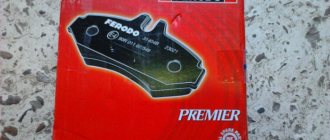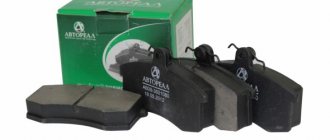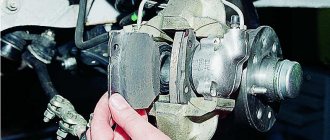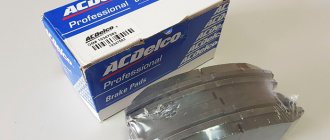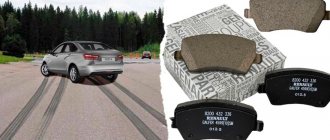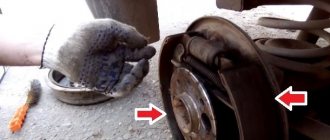When the time comes to replace brake pads in Largus, many Largus drivers begin to think about what kind of pads are installed on their car.
Surely they immediately turn to the Internet. And this is where difficulties may arise. Online stores offer brake pads for 8-cl and 16-cl engines, with and without ABS. The question involuntarily arises: “Which ones to choose?”
In order to accurately purchase the desired type of pads, I advise you not to be lazy, remove one wheel, look at the serial number of the part and use it to buy or order on the Internet. Better yet, check on both wheels. Otherwise, you risk missing.
You can also be guided by the appearance of the caliper. So on my 8-valve valve the following type of caliper is installed:
Looking ahead, I will say that it comes with pads with catalog number 410602192R .
How to find out when it’s time to change the pads on Largus
There are several types of diagnostics of car brake elements. The car owner must master the basic principles of checking brakes and make the right decision regarding further actions.
The first thing a car owner should pay attention to is signs of wear on the brake pads. They may manifest themselves in the following:
- extraneous sounds when braking;
- deterioration of the braking properties of the car;
- slight beating in the brake pedal;
- The handbrake stopped working.
All these symptoms indicate that it is necessary to check the brake system of the Lada Largus. First of all, you need to check the brake fluid level.
When the linings are fatally worn, the level drops noticeably. Therefore, if it has decreased, this is a signal for a full diagnosis of the pads.
The second step is a visual diagnosis of the pads. The condition of the front linings is assessed with the wheels removed.
If the residual thickness of the friction lining is less than 1.5 millimeters, this indicates severe wear and the need for urgent replacement.
To check the rear pads, you need to remove the drum. It is recommended to do this every 60 thousand kilometers. The permissible residual value of the lining is at least 1.5 mm.
Types of brakes
Compare lada largus and lada largus cross.
We are not afraid of potholes. or still not? In the automotive industry there are three main categories of brake mechanisms installed as standard:
- strip structures;
- drum systems;
- disc brakes.
The first “instances” at the dawn of the automobile industry had band brakes. This product covered the entire perimeter of the wheel rim, which allowed the driver to direct the braking force there at a certain moment. He could only pull the tape, which led to the slowdown of the “cart”.
Evolution has done its progressive work, and the outdated “ribbons” were replaced by drums, as in the Lada Largus. The principle of their operation was not intricate, but involved free rotation of the wheel paired with a drum, which, by expanding the pads present in its cavity, received the braking force, causing the car to slow down. This concept worked quite well, but over time some of its shortcomings became apparent. Here the intensity of the drum system has a special influence. The design is closed, and the pads overheat very quickly, which directly affects the deterioration of the braking effect. Along with excessive heating, moisture ingress turned out to be detrimental to the drum mechanism. The presence of water and dirt inside the assembly causes a decrease in performance. It is also not uncommon for a part to break inside a closed drum mechanism. On the one hand, the noise that appears will provide the driver with information about the breakdown that has occurred, and on the other hand, it can provoke damage to the internal working area of the drum itself.
The disc brakes installed in Lada Largus have proven to be the most reliable. In them, all the shortcomings inherent in the previous categories are completely leveled out. The operating principle is as follows. Paired with the wheel, the brake disc itself rotates until it is subjected to the compressive force of the pads. This action is possible by moving the brake rod from the cavity of the hydraulic cylinder present in the caliper. The disc uses a ventilation system that allows you to effectively cool the working area during intensive braking. Note that in the vast majority of cars only the front mechanisms are ventilated. Also, the fact that moisture gets on the disk cannot cause significant damage, since it dries quickly, and the remaining debris is spontaneously removed by centrifugal force. Although there are frequent cases of disc distortion due to frequent alternation of overheating and the passage of water “obstacles” (puddles). The disk mechanism better tolerates loads, so the entire system is as efficient as possible.
Due to the significantly lower cost of drum assemblies compared to disk counterparts, many manufacturers in their budget models resort to a combination of mechanisms, with disks in front and drums in the rear.
How to choose brake pads for Lada Largus
Before selecting analogues, you need to familiarize yourself with what the original spare parts look like in order to have a “standard” and not make a mistake with your choice. So, the article numbers for these elements are:
- 410602192R – front, for 8-valve engine;
- 410608481R – front, for a 16-valve engine;
- 7701210109 – rear.
Attention! It is worth considering that the pads for Largus equipped with K4M (VAZ-21129) and K7M (VAZ-11189) engines are different, as they have different calipers. Many people mistakenly believe that the pads have a difference: with and without ABS, but in fact, the difference is only in the engines.
Below is a clear difference between two brake pads for different configurations of the Lada Largus:
Having understood the difference, you can decide on the choice of analogues. Fortunately, the choice is quite large and below there is a table with article numbers of good budget and expensive substitutes with prices.
| Manufacturer | Article for 16 cells, front | Article for 8th grade, front | Article, rear |
| Finwhale | V1067 | V706 | VR811 |
| Sangsin | RP1564 | SP 1243 | SA191 |
| Pilenga | FD-P 3316 | FD-P 2885 T | BS-P 8455 |
| Hi-Q | SP1564 | SP1243 | SA191 |
| Bosch | 0 986 424 795 | 0 986 495 212 | 0 986 487 754 |
Hi-Q and Sangsin are considered to be the most optimal in terms of price/quality. Saving on pads will not lead to dangerous situations if the vehicle is operated in a calm manner.
But fast movements with frequent braking in the city will require really high-quality products. They will cost more accordingly.
The principle of operation of Largus brakes
Lada Largus is equipped with a modern European brake mechanism, which was developed through various tests and trials. The heir to Renault Logan adopted the quality and reliability of the brakes from its predecessor. The following service brakes are installed on the station wagon.
| Location and type | Characteristics |
| The front ones are disc. | The front ones are ventilated and have a floating bracket. |
| The rear ones are drums. | The rear brake system is a closed drum in which the centering of the pads is carried out independently using mechanisms that regulate the gap between the pads. |
The brake mechanisms are hydraulically actuated, are dual-circuit, arranged diagonally and have a vacuum booster. A huge plus in some trim levels is the presence of an anti-lock braking system (ABS), which has become an indispensable thing in modern cars. It prevents the wheels from locking during braking, in particular emergency braking. The handbrake is actuated mechanically by transmitting drive to the rear axle using a lever.
There are misunderstandings on various forums about whether the same pads are installed on Largus, which has an engine with 16 valves and which has 8 valves. On configurations with separate power units, different brake systems are installed with different calipers and brake disc dimensions. Therefore, its configuration depends on whether your car has 8 valves on the engine or 16 valves. Based on this, one or another mechanism is established.
The Lada's pads with a 16-valve unit are slightly better.
How to change front brake pads
To replace the pads, you will need a tool that consists of a wheel wrench, open-end wrenches 13 and 15, as well as a flat-head screwdriver, brake cleaner and caliper lubricant.
Almost no one uses lubricant and it’s a waste of time. Lubrication allows you to extend the life of the guides and reduce the likelihood of caliper knocking.
Simple pads are the easiest to change. To do this you need to perform a few simple steps:
- Lift the front wheel and remove it. Securely secure the vehicle to prevent accidental falls.
- Release the pads using a flathead screwdriver. To do this, insert it between the disc and the lining and pull it back with force until the piston sinks into the cylinder.
- Using a 13mm wrench, unscrew the lower bolt securing the caliper to the guide bracket. The finger must be kept from turning with a key at 15.
- Lift the caliper by turning it upward.
- Remove the old brake pads.
- Take out the metal brackets and clean off any dirt.
- Install new ones.
- Reassemble in reverse order.
We recommend that you familiarize yourself with the process visually using the following photographs:
Attention! It is definitely recommended to remove the caliper guides and lubricate them with special grease.
After replacing the pads, it is recommended to drive about 10-20 kilometers under several sharp braking conditions. In this way, the new pads are ground in and “accustomed” to normal operation. This procedure will help protect them from overheating, bending or destruction.
Causes of malfunction
The causes of rear brake pad failure are no different from the front ones. But it’s worth dwelling on them to know them:
- Wear of the friction part. It can only be seen if you take the drum apart. According to the manufacturer's recommendations, the friction part should not be less than 2 mm.
For comparison: on the left is a new brake pad, on the right is an old front brake pad
Tuning
Many car enthusiasts want to improve the rear brake; to do this, they replace the standard drums with ventilated disc brakes. This operation is done quite simply, but in frequent cases, the hub needs to be replaced.
Installing rear disc brakes
The old rear drums are thrown out and replaced with brake discs, calipers and front pads. This significantly improves the car's braking. These and Sparko offer a full set of rear ventilated brake discs.
As practice shows, disc brakes are 30% more efficient in use, and replacement is carried out in the same way as front brakes. In this case, you do not need to buy separate pads for the rear and front parts. It is enough to buy 4 sets of front pads (each set contains 2 pads).
Replacing rear brake pads on Lada Largus
With the rear brakes on Largus everything is a little more complicated. The process can cause difficulties even for an experienced car enthusiast, and the first problem is the drum that cannot be removed.
You can beat it endlessly with a hammer and split it at the end, or you can remove it carefully. To do this, we perform the following procedure:
- We remove the wheel.
- Clean the drum seats with a wire brush.
- We pour WD-40 on everything and leave it for half an hour. Now let's try to dismantle it.
Unlike classic VAZs, on Largus there are fewer problems with removing the drum, but it’s better not to count on a quick completion of the procedure.
Follow this procedure:
- Knock off the hub nut cap using a hammer and chisel.
- Unscrew the hub nut using a 36mm socket.
- Insert a flat-head screwdriver into the special hole, inside of which there is a mechanism that releases the drum pads. By turning the gear, the shoes can be loosened and the drum can be removed.
- Remove the rear pad clamps.
- Remove the lower tension spring, disconnect the handbrake cable from the wheel mechanism.
- All that remains is to separate the lower part of the pads and pull them out along with the retaining bar.
- Replace the brake linings and reassemble in reverse order.
The process is clearly described in the photo:
When assembling, the most important thing is not to forget anything. There is a high probability of losing the handbrake cable already under the bottom. To avoid this, do diagnostics more often and change pads less often.
Causes of malfunction
The causes of rear brake pad failure are no different from the front ones. But it’s worth dwelling on them to know them:
- Wear of the friction part. It can only be seen if you take the drum apart. According to the manufacturer's recommendations, the friction part should not be less than 2 mm.
For comparison: on the left is a new brake pad, on the right is an old front brake pad
Tuning
Many car enthusiasts want to improve the rear brake; to do this, they replace the standard drums with ventilated disc brakes. This operation is done quite simply, but in frequent cases, the hub needs to be replaced.
Installing rear disc brakes
The old rear drums are thrown out and replaced with brake discs, calipers and front pads. This significantly improves the car's braking. These and Sparko offer a full set of rear ventilated brake discs.
As practice shows, disc brakes are 30% more efficient in use, and replacement is carried out in the same way as front brakes. In this case, you do not need to buy separate pads for the rear and front parts. It is enough to buy 4 sets of front pads (each set contains 2 pads).
conclusions
Replacing the rear brake pads of a Lada Largus is a little more difficult than replacing the front ones. But at the same time, it is more than possible to change the elements yourself
Particular attention should be paid to the choice of pads, because braking efficiency depends on them
Brake pads in a car belong to the category of consumables, the scope of which involves gradual natural wear. This pattern also affects the modern Russian model of the universal class Lada Largus. The service life of the pads is directly influenced by the intensity of use and driving style. On the rear axle, these consumable components are replaced much less frequently than on the front axle, since the operating principle of the entire assembly is based on greater braking force on the front mechanisms.
In order for the replacement of rear brake pads on a Lada Largus car to be successful, you need a clear understanding of the structure of the brake unit, both as a whole and its individual components. Our material is aimed at considering the design features of the brake system parts and the sequence of manipulations that should be resorted to when the need arises to replace the rear pads. We will also provide a number of recommendations to extend the resource intensity of these consumables.


